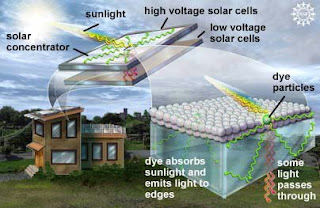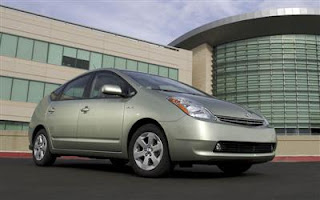 Photo / Donna Coveney
Photo / Donna CoveneyMarc Baldo, associate professor of electrical engineering and computer science (left) and Shalom Goffri, postdoc in MIT's Research Laboratory of Electronics (right) hold examples of organic solar concentrators.
 Photo / Donna Coveney
Photo / Donna CoveneyOrganic solar concentrators collect and focus different colors of sunlight. Solar cells can be attached to the edges of the plates. By collecting light over their full surface and concentrating it at their edges, these devices reduce the required area of solar cells and consequently, the cost of solar power. Stacking multiple concentrators allows the optimization of solar cells at each wavelength, increasing the overall power output.
 Image courtesy / Nicolle Rager Fuller, NSF
Image courtesy / Nicolle Rager Fuller, NSFAn artist's representation shows how a cost effective solar concentrator could help make existing solar panels more efficient.
Cost effective devices expected on market soon
Elizabeth A. Thomson, News Office
July 10, 2008
Imagine windows that not only provide a clear view and illuminate rooms, but also use sunlight to efficiently help power the building they are part of. MIT engineers report a new approach to harnessing the sun's energy that could allow just that.
The work, to be reported in the July 11 issue of Science, involves the creation of a novel "solar concentrator." "Light is collected over a large area [like a window] and gathered, or concentrated, at the edges," explains Marc A. Baldo, leader of the work and the Esther and Harold E. Edgerton Career Development Associate Professor of Electrical Engineering.
As a result, rather than covering a roof with expensive solar cells (the semiconductor devices that transform sunlight into electricity), the cells only need to be around the edges of a flat glass panel. In addition, the focused light increases the electrical power obtained from each solar cell "by a factor of over 40," Baldo says.
Because the system is simple to manufacture, the team believes that it could be implemented within three years--even added onto existing solar-panel systems to increase their efficiency by 50 percent for minimal additional cost. That, in turn, would substantially reduce the cost of solar electricity.
Read the entire story here.
(via. Massachusetts Institute of Technology)

